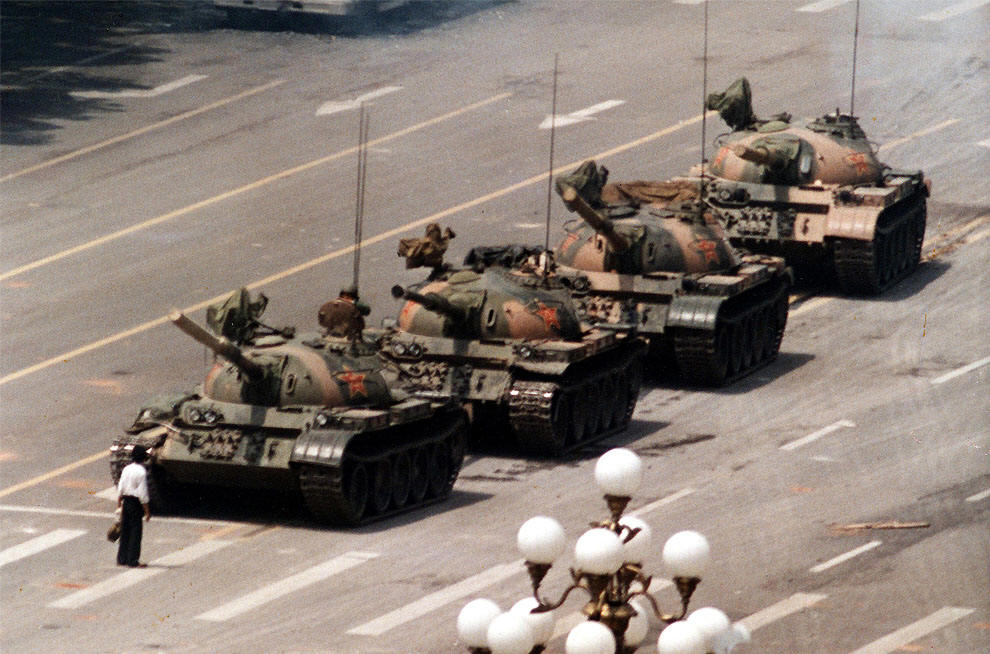http://www.cnd.org/June4th/massacre.html has some pictures.
https://ammo.com/articles/tiananmen-square-massacre-china-chinese-authoritarian-roots-tank-man puts a view and invites you to your ammo from him.
Tiananmen Square Massacre
ex Wiki
QUOTE
The Tiananmen Square protests of 1989, referred to in most
of the world as the Tiananmen Square massacre[citation
needed] and in the
People's Republic of China (PRC) as the June Fourth Incident
(officially to avoid confusion with two prior
Tiananmen Square protests), were a series of demonstrations in and near
Tiananmen Square in
Beijing
in the PRC beginning on 14 April 1989. Led mainly by students and
intellectuals, the protests occurred in a year that saw the
collapse of a number of communist governments around the world.
The protests were sparked by the death of a pro-democracy and anti-corruption official, Hu Yaobang, whom protesters wanted to mourn. By the eve of Hu's funeral, 100,000 people had gathered at Tiananmen square.[1] The protests lacked a unified cause or leadership; participants included disillusioned Communist Party of China members and Trotskyists as well as free market reformers, who were generally against the government's authoritarianism and voiced calls for economic change[2] and democratic reform[2] within the structure of the government. The demonstrations centered on Tiananmen Square, in Beijing, but large-scale protests also occurred in cities throughout China, including Shanghai, which remained peaceful throughout the protests.
The movement lasted seven weeks, from Hu's death on 15 April until tanks cleared Tiananmen Square on 4 June. In Beijing, the resulting military response to the protesters by the PRC government left many civilians and military personnel charged with clearing the square of the dead or severely injured. The number of deaths is not known, however, estimates include the initial Red Cross figure of roughly 3,000 and the second revised estimate of approximately 250 put forward following government pressure.[3][4]
Following the conflict, the government
conducted widespread arrests of protesters and their supporters, cracked
down on other protests around China, banned the foreign press from the
country and strictly controlled coverage of the events in the PRC press.
Members of the Party who had publicly sympathized with the protesters were
purged, with several high-ranking members placed under
house arrest, such as
General Secretary
Zhao
Ziyang. There was widespread international condemnation of the PRC
government's use of force against the protesters.
UNQUOTE
Tank man had lots of bottle.

"Tank
man" blocks a column of tanks heading east on
Beijing's
Chang'an Boulevard (Avenue of Eternal Peace) near
Tiananmen Square during the
Tiananmen Square protests of 1989. This photo was taken from the sixth floor
of the Beijing Hotel, about half a mile away, through a 400mm lens. We see bags
in his left hand indicating that he must have been on his way home from shopping
which raises the question was this a student protester or a man standing up for
students.
This photo was taken on June 5, 1989, by Jeff Widener (The Associated Press).
Written permission was received from the Associated Press on 29 January 2005, stating:
-
Wikipedia is only authorized to display this image to its users. Permission is not granted for copying or redistribution in or through any other medium. Image must be provided with the following credit: "Jeff Widener (The Associated Press)."